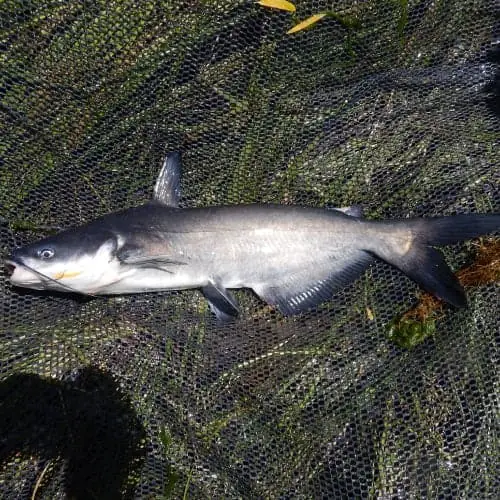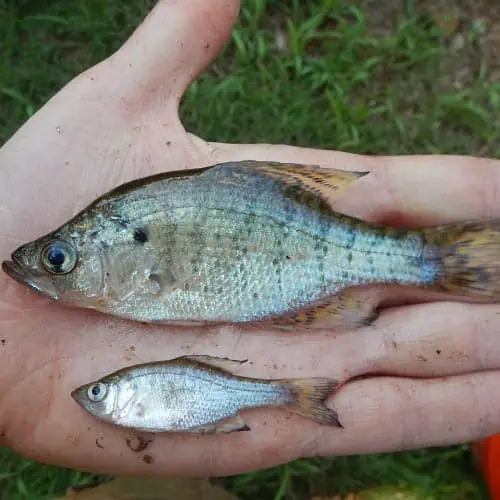
Lake Texoma is one of the largest lakes in the United States, found in both Oklahoma and Texas. It is encircled by two major state parks and is home to many fish species and recreational activities, including boating, camping, and fishing. Known to be one of the hotspots for striped bass, Lake Texoma also houses many species of catfish and bass.
As most of Lake Texoma is found in Oklahoma, it is recommended that Texan anglers purchase a fishing license specific to the lake if they wish to fish outside of the Texas portions. To preserve the various fish species and vegetation of Lake Texoma, anglers are advised to be conscious of preventing any spread of invasive species.
Lake Texoma is teeming with a variety of aquatic vegetation. Even though the vegetation is not found in large quantity, plants such as the American lotus, floating heart, bushy pondweed, and more can be found in and around the lake. Lake Texoma has a normal elevation of 615 to 619 ft but has reached the dam’s spillway at 640 ft multiple times.
Fish Species in Lake Texoma
1) Channel catfish (Ictalurus punctatus)

Like blue catfish, channel catfish have a deeply forked tail fin. They differ widely in color, from brown to slate-blue. What sets channel catfish apart from other species of catfish is the location of their jaw, the upper jaw jutting out far beyond the lower jaw.
Channel catfish feed primarily on a variety of insects, smaller fish, crustaceans, and even plant material. True to their name, channel catfish are found mostly in large streams with a lower current.
During spawning season, channel catfish will indent the riverbed to make a suitable cavity to store the eggs. Then the male catfish will guard the spots until the eggs hatch after about a week. Most channel catfish will be matured once they reach 12 inches in length.
Channel catfish can be caught with a variety of baits, including live insects, shrimp, cheese, and others. They can weigh up to 58 pounds but are usually more around 20 – 36 pounds. This species of catfish is highly invasive, and anglers are strongly encouraged to catch them.
2) Blue catfish (Ictalurus furcatus)

Blue catfish are one of the most popular sportfish among Texan anglers and are one of the largest freshwater fish. Blue catfish are very similar to channel catfish in diet and physical features. They have a forked tail and flat dorsal fin, with a white underbelly and an overall silver-blue color.
Blue catfish travel upstream during the summer to find cooler waters during the hottest months of the year. Their diet consists mostly of smaller fish and invertebrates. They grow to be very big and are found to be 20 – 40 pounds. On rare occasions, some blue catfish that weigh over 100 pounds can be found!
3) Flathead catfish (Pylodictis olivaris)

Flathead catfish differ from other catfish mainly by their flat head. They can reach a length of anywhere between 3 to 4 feet and can weigh up to 100 pounds. Normally a pale yellow or cream color, flathead catfish have a protruding lower jaw and an anal fin along the base of the belly.
Flathead catfish are said to be one of the fastest-growing fish in the United States. They reach maturity between 4 – 5 years old and have an average life span of 20+ years. They are found in large bodies of water, such as Lake Texoma and other surrounding reservoirs.
Another characteristic that sets flathead catfish apart is their diet. While other catfish are scavengers and have a wide scope of foods in their diet, fully grown flathead catfish are highly predatorial, entirely feeding on live fish. A fishing tip for any anglers wanting to catch these catfish is to use either a rod or reel with live bait, especially if fishing in areas around or below reservoir dams.
4) White bass (Morone chrysops)

As Oklahoma’s state fish, white bass are silver-white, with a dark back and white fleshy sides. They are a smaller fish species, with a more compact body and large scales.
When at Lake Texoma, one will see the most activity from white bass during the early spring, as they tend to spawn early in preferred areas such as running water surrounded by rocks. White bass are surface feeders, eating mostly insects, crustaceans, or other abundant food sources. In Lake Texoma, they usually grow to be about eight or nine inches in their first year. Some white bass can grow to be 12 – 15 inches long when fully matured.
As white bass feed and travel in schools, they are most easily caught with spinners and spooners when at the surface of the water. Another option is live bait (worms or grasshoppers), preferably during the night while the fish are at the bottom of the lake.
5) Striped bass (Morone saxatilis)

The biggest member of the sea bass family, striped bass have similar features to most bass, with a dorsal fin separated into sections and horizontal stripes along the sides. They are usually olive green. The striped bass is longer than the white bass and has two sharp points on the gill cover while the white bass only has one.
Striped bass are known to survive in both freshwater and saltwater environments. Spawning occurs during the spring when the temperature is mild. For the eggs to successfully hatch, they must be kept in motion by the current and have an ideal water temperature of 60 – 70 °F. Striped bass do not build nests as other fish do, but instead, keep the fertilized eggs afloat in the river current.
Striped bass have been able to spawn successfully in Lake Texoma, one of the few landlocked habitats for this bass. However, as the survival rate for the eggs that hatch is very low, especially due to the lack of current in the lake, the striped bass population in Lake Texoma is maintained by being stocked regularly. Artificial lures of small fish look-alikes, live bait, and cut bait can be used to catch striped bass.
6) Spotted bass (Micropterus punctulatus)

With numerous spots on their backs, spotted bass are similar in color to largemouth bass; a grayish to yellow/green color with a white underbelly. Spotted bass are not as commonly found as smallmouth and striped bass in Lake Texoma but are still a popular fish among anglers.
Spotted bass are quite different when it comes to their preferred habitat, which is normally an area with more of a current and warmer, more turbid water. This fish species builds nests on rocks or gravel that are suitable for spawning. The female will usually produce 1,150 to 47,000 eggs! Like most other fish, the males stay with the eggs until they hatch up to four weeks later, making sure they are protected from predators.
7) Smallmouth bass (Micropterus dolomieu)

Commonly green-yellow, smallmouth bass have dark, vertical splotches that cover up to at least half of their bodies. They have a slim body shape that allows them to be strong swimmers. Due to these characteristics, smallmouth bass have the ideal equipment to be highly effective predators; their color and speed allow them to successfully camouflage and ambush unknowing prey.
Smallmouth bass nests are most typically found near lake shores or any place that offers protection from strong currents or other harmful material. Eggs can hatch in about a week and a half as long as the temperature of the water is in the mid-’50s. However, the warmer the water, the faster the eggs will hatch. Sometimes even in 2 – 3 days from when the eggs were laid, the fry start to dispel!
Female smallmouth bass tend to be larger than males, and their diet consists of smaller fish, tadpoles, insects, and more. They are a very tough species and were introduced into Lake Texoma as a sportfish.
8) Largemouth bass (Micropterus salmoides)

Known as one of the most popular fish among anglers, largemouth bass are often introduced into lakes or rivers where they did not originate. Their original habitat is more protected areas, such as places with enough cover produced from rocks, vegetation, or even man-made structures.
Largemouth bass are the top predators in the aquatic ecosystem. From a young age, after reaching two inches in length, they become very active in their predatory behaviors. It is interesting to note that largemouth bass are much more effective predators and reach a larger size when adequate cover like vegetation or rock is available.
9) Black crappie (Pomoxis nigromaculatus)

Contrary to its name, the black crappie is more of a dark green-silver with irregular black spots fully covering its body. It differs from the white crappie by its body shape being deeper and more rounded. Crappies have one complete dorsal fin and black crappies specifically have up to seven or eight spines.
Being smaller in size, black crappies prefer to feed on plankton, crustaceans, and small fish, and tend to travel in schools. They can be found in bodies of water such as lakes, ponds, and reservoirs with little to no current.
Black crappies are nest builders and start in the spring. The males will build the nest first in preparation for the female crappie to come and lay the eggs. After 5 or more days, if the water temperature is ideal, the eggs will hatch and begin to grow.
10) White crappie (Pomoxis annularis)

White crappies have dark vertical lines running down the entirety of their body and are usually greenish-silver in color on top with a white underbelly. They have 5 to 6 spines on their dorsal fin, slightly less than black crappies.
White crappies, like black crappies, feed on small fish and insects. They are also nesters and once the fry hatch, they remain attached to the nest built by the male crappies for around 1 to 3 days. The fry must then fight to free themselves from the sticky substance that keeps them attached to the nest by swimming forcibly against it. Once away from the nest, the fry will feed on microscopic organisms and grow to be anywhere from three to five inches in the first year.
Crappies are very popular with both boat and bank anglers. They are easy to catch as crappies tend to be small, ranging anywhere from 1 to 6 pounds. It is suggested to use minnows to catch them, or any lure that resembles a small fish.
11) Bluegill (Lepomis macrochirus)

Having anywhere from 9 to 11 spines on its dorsal fin, bluegill tends to have an intense color compared to catfish, bass, or crappies. Starting with a blue or purple color on the head, the top of the bluegill can be dark green or blue that then transfers to a brown, orange, or yellow coloring across the belly of the fish. It is important to note that the more vibrant-colored bluegills are males that are breeding. Bluegills also have a very distinct black spot behind the back of their gills that looks like a little ear.
Unlike the other fish species found in Lake Texoma, bluegills begin breeding in late spring to early summer when water temperatures reach 68 to 80 degrees Fahrenheit. Bluegills are known to be colony spawners, meaning that up to 50 or more males could build nests in the same area during spawning season. Nests are highly protected by male bluegill until the eggs hatch and the fry leave.
As young fry, bluegills eat mostly plankton. As they fully mature, their diet shifts to larvae and insects. Full-grown bluegills in Lake Texoma can reach 2 pounds, and the biggest one on record was 4 pounds 12 ounces!


A few fish are missing from this list that I have seen from my boat slip on Lake Texoma. Needle nose gar and gator gar. Needle Nose Gar swim near the surface at night in the summertime, often in pairs. There is an abundance of shad in the lake as well.
I have also seen in golden eye fish which was caught in a throw net by a fishing guide.